Abstract
Traditional economic metrics' limitations in measuring sustainable development, specifically the use of Gross Domestic Product (GDP), have fostered a need for alternative models. The Inclusive Wealth (IW) framework proposes a comprehensive approach that includes produced, natural, human, and social capital within a unified index. This study critically reviews the development of development metrics and the necessity of a comprehensive evaluation of a nation’s wealth and welfare. Through the analysis of comprehensive wealth accounting methods, the study delves into how applying the IW framework delivers a superior estimate of long-term economic and environmental resilience. Empirical findings illustrate the disparities between the Global South and Global North and how conventional growth models disregard ecological degradation and social inequality. The study also tests the policy implications of using the IW framework with a focus on the framework’s application in formulating strategic interventions toward sustainable development. Overcoming the limitations of methods and the use of technology in analysing extensive data sets positions the IW framework as a valuable asset that policymakers may utilize in bridging development disparities and fostering inclusive development. The study emphasizes the need to move beyond GDP metrics and adopt a comprehensive wealth index that captures a nation's true economic and social welfare.
Introduction
In 2015, the world closely followed the dramatic development policy transformation that came with the ratification of Agenda 2030 and the 17 Sustainable Development Goals (SDGs). The SDGs were developed to replace the old Millennium Development Goals (MDGs), widening the scope of development at the world level beyond a narrow scope of reducing poverty and primary health to an overarching set of goals that incorporate education, gender equality, the environment, and climate change (Zhan & Santos-Paulino, 2021). Compared with the MDGs specifically addressing low-income countries, the SDGs are universal, appeal to all countries' efforts, and acknowledge that realizing sustainable development is a shared responsibility. However, with the inclusive articulation and ambitious scope of the SDGs came the realization of entrenched disparities and the widening Global South-Global North development gap. Traditional economic indicators such as the use of GDP have been widely criticized in the years gone by for measuring narrowly the exchange of goods and services within the market and not the degradation of natural capital, social inequality, and the depletion of human capital. Even if it captures the monetary value of goods and services that a nation produces, it fails to consider whether the economic output is sustainable and whether the gains are equitably distributed among the population (Polaskyet al.,2015). This failure has profound policy implications: Countries may appear to thrive while draining critical natural capital or expanding social disparities. Scholars and policymakers alike have therefore looked toward different models, such as the use of the UNEP’s Inclusive Wealth (IW) framework that captures a comprehensive picture of the wealth of a nation with the addition of the produced, natural, human, and social capital – aligning with the varied SDGs (figure 1). Despite the evolution in measuring development, there remains a huge gap in capturing the complexities of sustainable development. Traditional metrics like GDP fail to account for environmental degradation, social injustices, and the depletion of natural resources. Other approaches, like the Human Development Index (HDI), attempted to be more inclusive, but they fell short in incorporating vital elements like natural and social capital. This article bridges this gap by exploring the Inclusive Wealth (IW) framework, which provides a comprehensive approach to measuring the wealth of a nation through the incorporation of produced, natural, human, and social capital. Through a critical assessment of the IW framework, this study aims to assess whether it is more representative of sustainable development and whether it is applicable in informing policy interventions in closing the Global North-South gap.
Literature Review
Methodological Approaches to Comprehensive Wealth Accounting
Drawing on the challenges and possibilities identified above, this part outlines the methods of measuring sustainable development using the Inclusive Wealth (IW) framework. While conventional economic metrics such as the GDP take note of the market transactions alone—the IW framework captures the entire picture of a nation’s prosperity by including the valuation of the produced, natural, human, and social capital. This integrated framework captures not just the economic output of a country but also the ability of a country to sustain long-term welfare. It corrects the shortcomings that have been affecting the conventional metrics traditionally.
Underpinning the framework of the IW lies the conceptual framework of comprehensive wealth accounting that has been decades in the making and came about in the aftermath of criticism of the inability of the GDP to capture the depletion of natural capital and the degradation of social capital (Collins, 2014). Comprehensive wealth accounting seeks to put a price tag on the whole asset base of a nation—both the capital that will yield future returns. Herein lies the inclusion of the capital that has been produced, such as buildings and roads and machinery and factories, and natural capital, such as rivers and topsoil and forests and biodiversity. Since natural capital does not necessarily trade at readily measurable market prices, methods such as the Total Economic Worth (TEW) framework and the valuation of ecosystem services are applied to estimate the asset price of natural capital. The methods recognize ecosystems' services, such as water purification, carbon sequestration, and soil fertility, which support agriculture and public health (Costanzaet al.,1997).
Also central to this framework is the measurement of human capital. Classic methods such as income levels, attainment of education, and health results are used. However, a comprehensive analysis also encompasses intangible variables such as social connections that enhance a worker’s productivity and innovation abilities and cognitive skills that enhance an individual’s output and creativity (Singh & Shishodia, 2020). Produced capital is more straightforward to quantify because it lies in the transactions of the market; however, it is hard to gauge its real value accurately. Depreciation and underuse of capital might inflate the productive base of a nation if not correctly adjusted for. The IW system seeks not to do this with techniques such as life-cycle analysis and environmental appraisal that adjust the unseen maintenance and operation of physical capital with an accurate price tag. This ensures that the analysis of the produced capital not only looks at the quantum of it that it has but also its quality and the life of it. Another critical aspect is social capital, although it is more intangible and equally important in understanding the larger social landscape. Where social fragmentation and weak institutions prevail—the usual Global South problem—bundling social capital with the IW framework will reveal underlying issues that conventional economic metrics may not reveal (Blicharskaet al.,2017).
Greater methodological power of the IW framework with the application of the System of Environmental-Economic Accounting (SEEA) ensures that a standard framework of uniting the environment and economic statistics is provided so that policymakers can examine the interdependencies of economic activities and natural resource movements. This blend becomes highly useful in the developing world, where the environment deteriorates on a larger scale, and good statistics on the inventory of resources are not readily accessible (UNEP, 2018). Applying the SEEA ensures standardization of the environment and economic accounting processes. It helps make wealth comparisons among countries equitable and provides a good ground for developing policies.
Data collection and quality remain significant challenges, particularly in the Global South and in rapidly urbanizing regions of Asia, where statistical systems may lag behind economic and environmental changes (World Bank, 2021). Researchers increasingly utilize innovative methods such as remote sensing, big data analytics, and crowd-sourced information to overcome these limitations. These technologies enhance the granularity and timeliness of data, enabling more accurate tracking of changes in national wealth over time. Such technological innovations improve data quality and facilitate a dynamic assessment of how national wealth evolves in response to policy interventions and external shocks.
One of the strengths of the IW framework is that it has the power of disaggregation of the data at a scale that captures intra-national and intra-regional disparities. The Global South-North distinction does not play itself out at the international scale alone; it also plays it within countries. Urban centers within countries like India may be highly capitalized on produced and human capital, and rural areas are highly dependent on natural capital and subject to the uncertainties of the environment. Disaggregation of the statistics at a finer geographic scale allows policymakers to recognize localized issues and design interventions that enhance equitable and balanced development (Singh & Shishodia, 2020).
Also, the IW framework looks at the effect of private capital flows in determining a nation’s wealth. Foreign direct investment and private capital of any other forms can highly augment the capital created and induce employment generation (Ahmed & Zlate, 2014). However, if not appropriately regulated, the investments will enhance the deterioration of the environment and widen social disparities (Alfaro, Kalemli-Ozcan & Volosovych, 2008). The framework incorporates econometric models that quantify the effect of capital inflows on the wealth’s varied constituents based on the quantum of investment, the investment’s quality, and the sectoral dispersion of investment. This analysis becomes highly crucial in the Asian emerging economies, wherein investment attraction and maintaining sustainable processes require a delicate balance.
Collective efforts at standardizing the methods of measuring further enhance the credibility of the IW framework. Global organizations such as the United Nations University International Human Dimensions Programme (UNU-IHDP) and the UNEP have been leading efforts to standardize methods of collecting and measuring the data. Standardization becomes vital in making meaningful cross-country comparisons and the construction of a homogeneous world database of wealth (UNU-IHDP & UNEP, 2012). The efforts bridge the data gap between the developed and the developing world and enable the world to arrive at sustainable, comprehensive, and equitable development assessments.
Despite such improvements, methodological issues remain. One of the critical issues involves the issue of substitutability between capital forms. How far does the produced capital replace the natural capital depletion at the expense of long-term sustainability? Whilst short-term substitutability might be feasible, heavy dependence on the use of capital that has been manufactured instead of natural capital will cause irrevocable degradation of the environment and erode the nation's welfare (Collins, 2014). Solutions to such issues need complex simulation methods and a profound insight into the underlying economic and natural processes. Another area of emerging methods lies in the confluence of knowledge capital. The modern world’s information economy has technology and research at the centre of enabling sustainable development. Measuring the capital of knowledge has been an issue because it does not manifest physically. Researchers are trying proxies such as R&D expenditure, patents and patents per million population, and the index of innovations in a bid to put the capital of knowledge into quantitative figures. Placing such metrics within the framework of the IW will present an even richer picture of a nation’s long-term growth and resilience abilities (Mohan, 2017).
However, even if Inclusive Wealth (IW) is a complete framework for measuring national prosperity, it has its own limitations too (Roman & Thiry, 2016). For example, the valuation of intangible capital, such as human and social capital, wherein the paucity of data and methodological complexities lead to errors. Further, the application of shadow pricing in non-market assets, such as the services of the environment, raises uncertainties since such valuations would be subjective in nature. Besides, substitutability across capitals has been questioned, as this could be oversimplifying interdependencies among produced, natural, human, and social capital, which in actuality is much more nuanced. These weaknesses mean that, while the IW framework is superior to traditional metrics like GDP, caution must be exercised in utilizing it so that policymakers' decisions would be informed by robust and context-specific assessments.
In brief, the methodological strategies behind the IW framework are exhaustive and cross-cutting. Bringing quantitative models together with qualitative analysis and conventional survey methods, the strategy covers the whole spectrum of capital that constitutes the wealth of a nation. Unbundling the data, including private capital movements and applying state-of-the-art valuation methods, enables the IW framework to spot development issues and inform targeted interventions in the policy space. The progressive improvement of such methods with the aid of technology and the synergy of collaborative efforts has the promise of bridging existing gaps and ushering in a future of inclusive, sustainable, and resilient development in the Global South and the Global North.
Inclusive Wealth Framework: Empirical Insights And Policy Implications
The Inclusive Wealth (IW) framework constitutes a conceptual shift in defining and measuring a nation’s wealth. Moving beyond the standard economic metrics of GDP, the IW framework synthesizes produced, natural, human, and social capital into a unified index of sustainable development. This multiple-dimension framework captures the capital that delivers short-term economic output and factors in a nation’s capacity to sustain and augment the welfare of current and future populations. In effect, the IW framework hinges on the premise that a country’s wealth does not lie in the economy's short-run output but in the economy's overall capital asset base. The capital that has been built is the driver of economic output—tangible capital, such as factories and machinery and roads—while natural capital, such as woods, freshwater, soils, and biodiversity, provides the critical system services—like the management of the climate system, the purification of freshwater sources, and soils’ fertility—that sustain agriculture and public health (Costanzaet al.,1997). The inclusion of natural capital in wealth calculations underscores the inseparability of economic development and the environment; the natural capital erodes, and the critical services it delivers diminish with it at the expense of long-term wealth if the capital that has been built goes on expanding. Another of the pillars of the IW framework is human capital, which captures the sum of a country’s workforce’s knowledge, skills, and health. Human capital is also a complex asset and is usually estimated with proxies of education attainment, state of health, and income levels. Good human capital increases productivity and stimulates technology development, yet investment shortfalls in education and public health reinforce poverty and social disparities (Singh & Shishadia, 2020). The IW framework, therefore, captures a fuller picture of development, recognizing that investment in human capital plays a critical part in sustainable development. The Inclusive Wealth Report 2024 includes the Social and Emotional Capital Accounts (SECA) within the definition of human capital with the recognition of the influence of social and emotional skills on education workforce productivity and general welfare (UNESCO MGIEP, 2024) (see Table 1).
| Country | Academic Performance | Drug Use | Dropout Rates | Delinquent Behaviors | Mental Health |
|---|---|---|---|---|---|
| USA | ↑ (10.64%) | ↓ | ↓ | ↓ | ↑ |
| UK (England) | ↑ (11.03%) | ↓ | ↓ | ↓ | ↑ |
| India | ↑ (7.14%) | – | ↓ | – | ↑ |
| China | ↑ (7.53%) | – | ↓ | – | ↑ |
| Netherlands | ↑ (10.26%) | ↓ | ↓ | ↓ | ↑ |
Source: UNESCO MGIEP. (2024). Inclusive Wealth Report: Special Issue on Social Emotional Capital Accounts. New Delhi: UNESCO MGIEP.
While more abstract, social capital supplements it with the institutions, social networks, and social norms that allow collaborative effort and social cohesion. Good social capital facilitates good governance and resilience at the grassroots level, a prerequisite for using sustainable policies. Even with the resilience of the other forms of capital with institutional shortcomings or social fragmentation within a site, a lack of social capital will impede development (Blicharska et al., 2017). Adding social capital within the IW framework captures qualitative development factors that quantitative methods often omit. One of the strengths of the IW framework is that it captures the trade-offs and interactions among the multiple forms of capital. Fast industrialization might yield tremendous increases in produced capital, yet long-term sustainability will be at risk if it happens at the expense of exhausting natural capital. Likewise, a country might record tremendous economic growth while simultaneously losing human capital through a failure to invest in education and the provision of good healthcare. The IW framework captures such dynamics and weighs them in monetary terms, equipping policymakers with a comprehensive picture of the long-term sustainability of the development strategy they adopt. This line of thought becomes highly relevant in the modern-day integrated world economy. Empirical uses of the IW framework have repeatedly confirmed the framework’s applicability. The United Nations Environment Programme’s 2018 Inclusive Wealth Report chronicles those numerous countries with strong growth in produced capital experience significant declines in natural capital. The situation is particularly pronounced in the fastest-industrializing countries and areas, where natural capital depletion—like deforestation, water shortages, and soil degradation—destroys long-term economic resilience. Under such a scenario, the IW framework plays the role of an early warning system, indicating that it is insufficient to sustain development with a short-term output strategy that diminishes the overall capital stock instead of preserving or expanding it. An example of IW principles informing policy is the case of the management of natural resource wealth in Norway. Traditional indicators such as GDP indicated strong economic growth, but Inclusive Wealth accounting indicated that this was done through the extraction of finite oil and gas reserves to the detriment of future wealth. This was balanced through the establishment of the Government Pension Fund Global (GPFG), a sovereign wealth fund that converts petroleum revenues to investments in finance and human capital (Centre for Public Impact, 2023). The fund invests in global shares, infrastructure, and sustainable assets that maintain Norway's comprehensive wealth per capita while safeguarding the economy from the risks of dependence on natural resources. Despite the achievements, there are challenges that include the need to ensure that the exhaustion of natural capital will be offset through the investment of the same or higher amounts in human and social capital. The IW framework also reveals significant intra-country disparities. For instance, urban centers in countries like India accumulate large sums of produced and human capital. However, rural centres still highly depend on natural capital and are subject to natural shock risk. The intra-country disparities also reveal the more considerable Global North-South disparities and the skewed wealth and opportunity distribution among countries. By applying the IW framework and geographically disaggregating the data, policymakers can design interventions that specifically address localized issues and build equitable development (World Bank, 2021). Aside from empirical analysis, the IW framework also has significant consequences for policy formulation. The availability of a comprehensive measure of a nation's wealth constitutes a diagnostic that will enable the government to identify significant weaknesses and adopt top-priority interventions. Where natural capital is eroding, conservation and sustainable management of natural capital and restoration of ecosystems may be the government's interventions. Where human capital shortages dominate, investment in training and education and provision of good health becomes a necessity. The comprehensive framework of the IW ensures that such interventions get synchronized to push overall sustainable development and not be done in a disconnected manner. One of the transformative strengths of the IW framework also lies in the capacity to foster cross-country cooperation and the bridging of the Global South-Global North development divide. The conventional metrics of economic output, such as the GDP, often obscure underlying disparities by measuring economic output alone. The IW framework, however, includes the degradation of the environment, social disparities, and human development, which delivers a more inclusive foundation of comparison among countries. This inclusive framework stimulates the cross-country exchange of technology, knowledge, and good practices among developed and developing countries—a prerequisite for addressing trans-country issues such as the environment and climate change that demand cross-country cooperative efforts (Arrowet al.,2012). In summary, the IW framework delivers a route toward attaining inclusive, equitable, and resilient development as countries contend with the forces of fast-paced industrial development, changing environments, and globalization of the world economy. Its empirical use and conceptual basis emphasize the power of the framework to transcend the long-standing Global South-Global North divisions and assure that development reaches every part of society while protecting the welfare of future populations.
Conclusion
Reimagining Sustainable Development
The Inclusive Wealth framework provides an integrative approach to assess sustainability that emphasizes the practical use and the challenges to implement it. Some important takeaways are the necessity to channel resource rents to human and physical capital and the necessity to have strong accounting frameworks to reflect the natural asset stock within the framework of development planning. The future research agenda will need to address the necessity to create new methodologies to enhance the measurement of intangible capital (such as social, health, or institutional capital) and to bridge the data gaps at the sub-national levels to ensure the estimates are made more precise and policy-relevant. Lastly, investigating the policy innovations will be essential, such as the use of inclusive wealth indicators within the budgets, the national development strategy, or international development targets. Such innovations will be able to raise the framework's use and efficacy to the next level, ensuring that the framework does not only measure sustainability but also steers the decision-makers to invest in the long-run wealth of nations instead of the short-run gains, guiding the economies to a more sustainable future path.
Conflicts of Interest
I affirm that there are no potential conflicts of interest and I agree to abide by the IIJASSAH's policies.
Acknowledgment
This paper is based on original research from author’s PhD work at the School of Management, BML Munjal University. Support from the SYLFF Research Grant (SRG), awarded by the Tokyo Foundation, enabled him to discuss the Inclusive Wealth Framework at the UNEP headquarters in Nairobi, Kenya, contributing to its application at the Indian subnational level. It helped him to finalise his doctoral thesis, and this paper is one of its key research outputs. Author is also profoundly grateful to his supervisor, Prof. Sangita Dutta Gupta, and his co-supervisor, Dr. Nilanjan Ghosh, for their invaluable guidance.
References
- Ahmed, S., & Zlate, A. (2014). Capital flows to emerging market economies: A brave new world?. Journal of international money and finance, 48, 221-248. https://doi.org/10.1016/j.jimonfin.2014.05.015
- Alfaro, L., Kalemli-Ozcan, S., & Volosovych, V. (2008). Why doesn't capital flow from rich to poor countries? An empirical investigation. The Review of Economics and Statistics, 90(2), 347–368. https://doi.org/10.1162/rest.90.2.347
- Arrow, K. J., Dasgupta, P., Goulder, L. H., Daily, G., Ehrlich, P., Heal, G., & Levin, S. (2012). Sustainability and the measurement of wealth. Ecological Economics, 88, 108–118. https://doi.org/10.1017/S1355770X12000137
- Blicharska, M., Teutschbein, C., & Smithers, R. J. (2017). Steps to overcome the North–South divide in research relevant to climate change policy and practice. Nature Climate Change, 7(1), 21–27. https://doi.org/10.1038/nclimate3163
- Centre for Public Impact. (2023). The Government Pension Fund Global (GPFG) in Norway. Retrieved from https://centreforpublicimpact.org/public-impact-fundamentals/the-government-pension-fund-global-gpfg-in-norway/
- Collins, R. D. (2014). Using inclusive wealth for dynamic analyses of sustainable development: Theory, reflection, and application. In The 32nd International Conference of the System Dynamics Society. Retrieved from https://www.researchgate.net/publication/269093953_Using_inclusive_wealth_for_dynamic_analyses_of_sustainable_development_Theory_reflection_and_application
- Costanza, R., d’Arge, R., De Groot, R., Farber, S., Grasso, M., Hannon, B., Limburg, K., et al. (1997). The value of the world’s ecosystem services and natural capital. Nature, 387(6630), 253–260. https://doi.org/10.1038/387253a0
- Mohan, D. (2017, March 3). Why is the government still obsessing over GDP statistics? The Wire. Retrieved from https://thewire.in/economy/gdp-statistics
- Polasky, S., Bryant, B., Hawthorne, P., Johnson, J., Keeler, B., & Pennington, D. (2015). Inclusive wealth as a metric of sustainable development. Annual Review of Environment and Resources, 40, 445–466. https://doi.org/10.1146/annurev-environ-101813-013253
- Roman, P., & Thiry, G. (2016). The inclusive wealth index: A critical appraisal. Ecological Economics, 124, 185–192. https://doi.org/10.1016/j.ecolecon.2015.12.008
- Singh, S., & Shishodia, A. (2020). Environmental sustainability and inclusive wealth in India. Journal of Environmental Management, 270, 110865.
- UNEP. (2018). Inclusive Wealth Report 2018: Measuring progress toward sustainability. Cambridge University Pre
- UNEP. (2023). Inclusive Wealth Report 2023: Measuring Progress Towards Sustainability. Nairobi, Kenya: United Nations Environment Programme.
- UNESCO MGIEP. (2024). Inclusive Wealth Report: Special Issue on Social Emotional Capital Accounts. New Delhi: UNESCO MGIEP.
- UNU-IHDP & UNEP. (2012). Inclusive wealth report 2012: Measuring progress toward sustainability. Cambridge University Press
- World Bank. (2021). The changing wealth of nations 2021: Managing assets for the future. Retrieved from https://hdl.handle.net/10986/36400
- Zhan, J. X., & Santos-Paulino, A. U. (2021). Investing in the sustainable development goals: Mobilization, channeling, and impact. Journal of International Business Policy, 4(1), 166–183. https://doi.org/10.1057/s42214-020-00093-3












